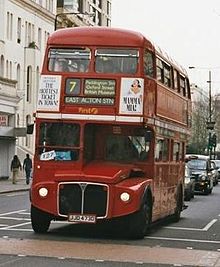Park Royal Vehicles
The Park Royal Vehicles , also Parkroyal or PRV was a manufacturer of bodies for buses and rail vehicles from Park Royal , England. The company existed from 1930 to 1980, but its roots can be traced back to 1889.
history
Together with Charles H. Roe , Park Royal Vehicles was one of the oldest and most important coachbuilders in the United Kingdom . The company was founded as the Hall Lewis Company in 1889 and engaged in the manufacture of bodies for carriages , road vehicles and rail vehicles. Park Royal Coachworks emerged from the bankruptcy estate of the company in 1930 . The company was owned by Harry Yager, a major creditor of the Hall Lewis Company , until 1946 . In 1946 the name was changed to Park Royal Vehicles , and in the following year, Charles H. Roe Ltd. taken over in Leeds one of the oldest competitors.
In 1949 Park Royal Vehicles became a part of Associated Commercial Vehicles Ltd (ACV), which also included Associated Equipment Company (AEC). AEC manufactured chassis for buses and trucks . In 1962 ACV merged with its subsidiaries and Leyland, six years later Leyland Motors was renamed Leyland Motor Corporation and now comprised most of the British automotive industry and a considerable part of the supplier companies. Leyland was nationalized by the Labor government in 1975. As a result of the crisis in the British automotive industry, Leyland was forced to close subsidiaries from the end of the 1970s. AEC was closed in 1979, PRV in July of the following year.
vehicles
The amalgamation of coachbuilders and chassis manufacturers under the umbrella of ACV proved to be advantageous, as the requirements of large bus transport companies such as London Transport could be met more easily through coordinated designs. The AEC Routemaster produced by AEC and PRV was a step towards the self-supporting bus. Up until the 1980s it was also common for chassis and superstructures for buses to be manufactured by different manufacturers. Since the chassis (front and rear subframe) of the Routemaster manufactured by AEC were provided exclusively with PRV superstructures, the frame and superstructure constructions could be optimized, which, in addition to the use of aluminum, led to a lighter vehicle. A total of 2873 Routemasters were produced from 1954 to 1968 in various versions, the vast majority for London.
In addition to bodies for buses, Park Royal Vehicles also manufactured bodies for other vehicles. For example, the first London taxi with a diesel engine was bodied by PRV. PRV was also involved in the production of the Bristol models 407 to 411 ; the company supplied the bodyshells for the luxury vehicles from Filton until 1976.
In 1958 PRV manufactured the bodies for five British Rail class 79970-74 rail buses . British Rail's Class 103 production had already started last year. A total of 40 of these two-part diesel multiple units were produced.
During the Second World War , the engine fairings and outer wings of the Handley Page Halifax bomber were produced at PRV . In addition, they were busy with the production of bodies for various military vehicles. From November 1954 to January 1955 PRV built the superstructures for 150 Green Goddess military fire trucks .
Leyland Tiger with structure from PRV
AEC Renown with the establishment of PRV
AEC Regent with the establishment of PRV
Leyland Titan with structure from PRV
Daimler Fleetline with development of PRV





